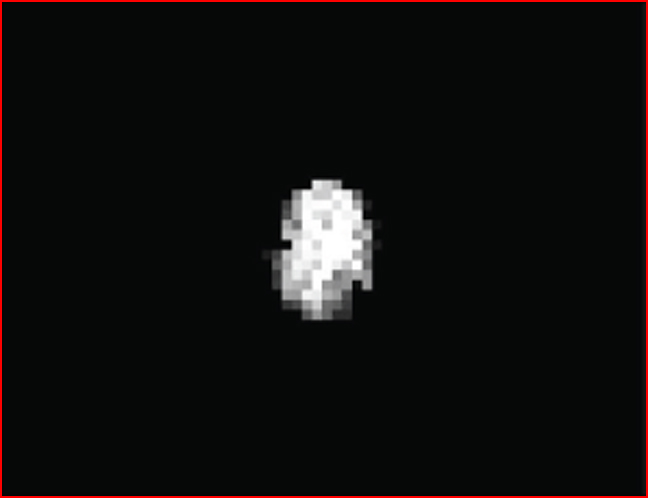
home •
about •
essential guide •
picture of the day •
thunderblogs •
news •
multimedia •
predictions •
products •
get involved •
contact
picture of the day archive subject index
Asteroid 2007 TU24. Credit: Arecibo/Greenbank Observatory
Jan 30, 2008
A Miss is as Good as a MileDespite "doomsday" fears of an asteroid collision, TU24 has once again faded into obscurity without any dramatic developments.
On October 11, 2007, the Catalina Sky Survey detected the first sign of a Near Earth Object (NEO) dubbed 2007 TU24. The initial orbital calculations seemed to show that the 250-meter chunk of space rock had a slim chance of passing close to our planet possibly within the orbit of the Moon. However, the most recent data indicates that it flew by Earth at a distance of approximately 538,000 kilometers half again as far as the Moon on January 29, 2008, at 3:33AM EST.
Scientists from the Jet Propulsion Laboratory in Pasadena, California, analyzed the newest data from the Goldstone Solar System Radar telescope and determined that there is no chance the asteroid will ever come within striking distance of the Earth. Previous Picture of the Day articles note that asteroids and large meteors are rarely, if ever, going to impact the Earth in the first place.
In the Electric Universe view, any object coming far from the earth will carry a different charge. As it encounters lower layers of the Earth's plasma sheath, the voltage between the object and the layer could abruptly increase and the object begin to visibly discharge.
At first it would be surrounded by a glow discharge, a diffuse luminescence similar to St. Elmos fire or to high-altitude elves. As the voltage rises, the discharge would jump to arc mode and the object would become an electrode at the focus of upper-atmospheric charge. At this point material would begin to ablate in a sputtering process as well as from velocity-caused air friction.
If the current flow becomes too extreme, capacitive discharges within the meteor will cause a violent outburst of electricity with sudden bright flashes. The meteor is now called a "bolide," or flaring meteor.
Electrical effects within semi-metallic objects prompted some Electric Universe correspondents to wonder if such a flare (or a glow discharge) might appear during the 2007 TU24 flyby. The short answer is that the object is far too small, plasma in space is far too diffuse, and its encounter with Earth was at too great a distance for any such phenomena to appear.
2007 TU24 followed closely on the heels of Asteroid 2007 WD5 which was predicted to smash into the surface of Mars on January 30, 2008. As of January 11, however, the odds were reduced to a 1-in-10,000 chance that there would be a Martian catastrophic event. Once again, we predict that there will be no visible effects of any kind as 2007 WD5 proceeds past Mars and back into the depths of space.
By Stephen Smith
__________________________________________________________________________Please visit our new "Thunderblog" page
Through the initiative of managing editor Dave Smith, weve begun the launch of a new
page called Thunderblog. Timely presentations of fact and opinion, with emphasis on
new discoveries and the explanatory power of the Electric Universe."The Electric Sky and The Electric Universe available now!

|
|

|
EXECUTIVE EDITORS:
David Talbott, Wallace Thornhill
MANAGING EDITORS:
Steve Smith, Mel Acheson
CONTRIBUTING EDITORS: Michael Armstrong, Dwardu Cardona,
Ev Cochrane,
C.J. Ransom, Don Scott, Rens van der Sluijs, Ian Tresman
WEBMASTER: Brian Talbott
Copyright 2008: thunderbolts.info
![]()
home
thunderblogs
forum
picture of the day
resources
team
updates
contact us

